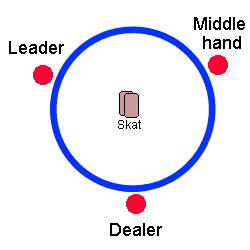|
Principles of the German "SKAT" card game - page 3
Previous - Contents - Next
SK 4 - The Auction
 The Middle hand has the privilege to start the auction, bidding initially against the Leader.
The Middle hand has the privilege to start the auction, bidding initially against the Leader.
"Do you have 18 ?" the Middle hand asks.
"Yes" is the Leader's reply.
"What about 20 ?"
and "Yes" is again the Leader's response.
This goes on until eventually one of the two players has reached his limit (as calculated) and has to pass.
Now it is the turn of the Dealer to bid against the survivor in the auction, be it the Middle hand or the Leader.
Throughout the auction it is always the caller who is at a disadvantage, because every time he has to make the higher bid. The responder (initially the Leader) has only to match the call to earn the right to the contract.
Previous - Contents - Next
SK 5 - The Play
Eventually one of the three players wins the auction and may decide and play the contract.
Unless he plays "from the hand" he picks up the two cards in the SKAT. He may add these to his hand as he wishes, putting two other cards back into the Skat. The Skat cards are his and will be added to his final card point score.
The play can now begin.
Declarer designates the type of contract (Grand, suit game, Nil or Uno) and trump suit as appropriate, and the Leader plays his card to the first trick.
Whoever wins the trick leads to the second one, etc.
The objective of the play for the Declarer is to catch as many card value points in his winning tricks as possible.
Card value points are :
Ace = 11 pts 10 = 10 pts K = 4 pts Q = 3 pts J = 2 pts
There are therefore 30 points available in each suit, 120 points in the whole game.
In order to make his contract Declarer must capture 61 points or more in his winning tricks.
Both opponents join up in playing against him, and will try together to catch 60 tricks or more in their winning tricks.
When the opponents catch less than 30 points in their tricks they are Taylor, and the Declarer can add 1 to his multiplication factor.
The SKAT
There can be a catch with the Skat however.
Say you hold :
J♥ - A♠ - K♠ - 9♠ - 8♠ - A♥ - Q♥ - 7♥ - Q♣ - 8♣
During the auction the opponents pushed you up to your maximum value : Without 2, Game 3 x 11 = 33
But when you pick up the Skat you find that one of the two cards in it is the J♣
This means that your hand's auction value now has been reduced to : With 1, Game 2 x 11 = 22
You don't say anything to your opponents of course, but how do you proceed now ?
Luckily you also picked up the 7♠ from the Skat. You therefore put the two Clubs from your hand into the Skat.
J♣ - J♥ - A♠ - K♠ - 9♠ - 8♠ - 7♠ - A♥ - Q♥ - 7♥
Now, with a 7-card long trump suit and only two suits in your hand you have a good chance to achieve a Taylor. This will upgrade the auction value of your hand again to 33 (With 1, Game 2, Taylor 3 x 11).
Previous - Contents
SK 6 - The Scoring
The scoring is very easy.
When you win you score the maximum auction value of your hand at the end of the play.
For example your initial value was : With 2, Game 3, Taylor 4, Taylor Declared 5 x 9 = 45 (trump suit was Diamonds), but you managed to win all 10 tricks (a Whitewash).
Now you can score : With 2, Game 3, Taylor 4, Taylor Declared 5, Whitewash 6 x 9 = 54
When you loose your negative score is double of the maximum auction value of your hand OR the actual bid you made during the auction, whichever is the higher.
For example if you had bid up to 36 during the auction (Without 2, Game 3 x 12 = 36 (Clubs were trumps) and collected only 60 points or less during the play you loose 2 x 36 = - 72 points.
If, with the same hand as above, you had bid 36, and then found the J♣ in the Skat reducing the auction value of your hand to : With 1, Game 2 x 12 = 24, you would still loose (2 x - 36 =) - 72 points.
Scoring in RAMSCH
When during the auction none of the three players made a single bid, the Ramsch game is played. The loser is the player who collects the most card value points in his winning tricks. His loss score will be equal to the total points he collected.
If however one of the two other players did not win a single trick* during the play, the loser will loose double the amount of points he collected in his tricks.
* The player who did not win a single trick is then called the "Jungfer".
Previous - Contents - Next
Copyright © 2011 Michael Furstner
|
 The Middle hand has the privilege to start the auction, bidding initially against the Leader.
The Middle hand has the privilege to start the auction, bidding initially against the Leader.